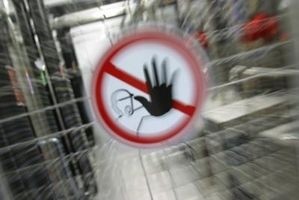Four Pillars Of Safety Management

When accidents happen due to negligence or a lack of safety rules, companies can face penalties in terms of finances and public credibility. Smaller businesses can even lose the tools they need to stay in business. Thus, safety management should be a priority in any company. The main purpose of a safety management system is to establish standards and procedures to effectively identify and control possible risks. The four pillars of an SMS are the safety policy, the management of risks, the safety assurance and the promotion of safety procedures.
SMS Policy
The SMS policy designates top management as the authority responsible for ensuring that safety rules are observed by employees at all levels of the company's structure. Safety policies establish procedures and risk controls to evaluate to what extent safety rules are implemented as designed. Safety policy requires managers to give designated people the responsibility and authority to see these policies carried out. Safety policy also deals with the financial resources allocated to monitor employees' activities in terms of risk-free procedures and improve controls where necessary.
Risk Management
The risk management component consists of a set of procedures to identify, analyze and evaluate risks and to develop controls that can prevent them. The system analyzes the interaction among different components of an organization---people, facilities, technology---and the environment. This analysis may lead to identifying risks that can be prevented or eliminated by risk controls that may involve changes in equipment, training and staffing arrangements, or additions in equipment, technology, procedures and supervisory controls. If the modified system gives positive results, it should be implemented and monitored to ensure its effectiveness.
Safety Assurance
Safety assurance uses efficient auditing, analysis and review systems to ensure that risk controls are still effective over a certain period of time and in a changing environment. The purpose of this SMS component is to constantly improve the quality of the products and processes involved while maintaining acceptable risk levels. Safety assurance includes feedback on performance, so it can be considered a means of identifying the areas to be improved. It also includes procedures to develop preventive or corrective actions and to monitor their effective implementation.
Safety Promotion
Promoting safety procedures refers to managers' capability to positively influence the employees' way of thinking and acting toward a safe workplace environment. Safety promotion consists of informing people at all company levels about the safety practices in effect at a certain time. An important element of safety culture is the openness of communication between management and employees. Employees should be informed of how and where to report a safety hazard so that the manager can take measures to correct or prevent it.
SMS Policy
The SMS policy designates top management as the authority responsible for ensuring that safety rules are observed by employees at all levels of the company's structure. Safety policies establish procedures and risk controls to evaluate to what extent safety rules are implemented as designed. Safety policy requires managers to give designated people the responsibility and authority to see these policies carried out. Safety policy also deals with the financial resources allocated to monitor employees' activities in terms of risk-free procedures and improve controls where necessary.
Risk Management
The risk management component consists of a set of procedures to identify, analyze and evaluate risks and to develop controls that can prevent them. The system analyzes the interaction among different components of an organization---people, facilities, technology---and the environment. This analysis may lead to identifying risks that can be prevented or eliminated by risk controls that may involve changes in equipment, training and staffing arrangements, or additions in equipment, technology, procedures and supervisory controls. If the modified system gives positive results, it should be implemented and monitored to ensure its effectiveness.
Safety Assurance
Safety assurance uses efficient auditing, analysis and review systems to ensure that risk controls are still effective over a certain period of time and in a changing environment. The purpose of this SMS component is to constantly improve the quality of the products and processes involved while maintaining acceptable risk levels. Safety assurance includes feedback on performance, so it can be considered a means of identifying the areas to be improved. It also includes procedures to develop preventive or corrective actions and to monitor their effective implementation.
Safety Promotion
Promoting safety procedures refers to managers' capability to positively influence the employees' way of thinking and acting toward a safe workplace environment. Safety promotion consists of informing people at all company levels about the safety practices in effect at a certain time. An important element of safety culture is the openness of communication between management and employees. Employees should be informed of how and where to report a safety hazard so that the manager can take measures to correct or prevent it.
- o3cf5886a5553408a49a76d2af3203aca2.jpg